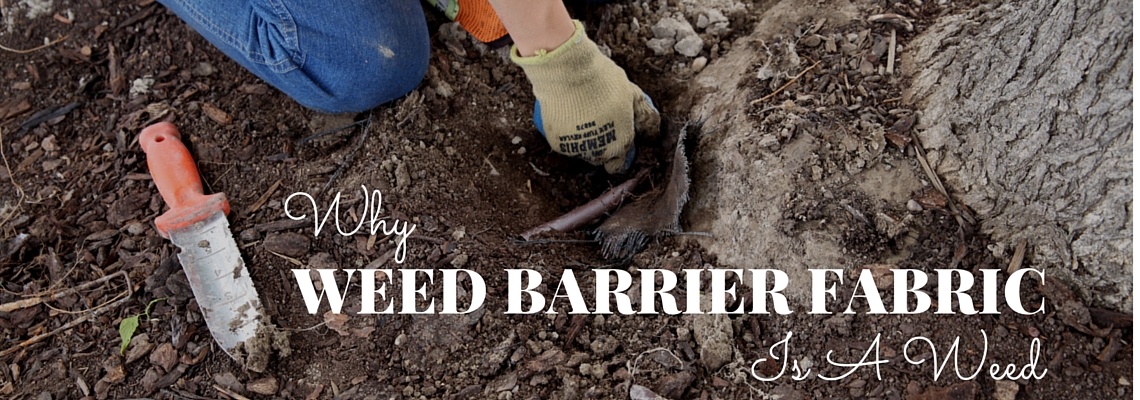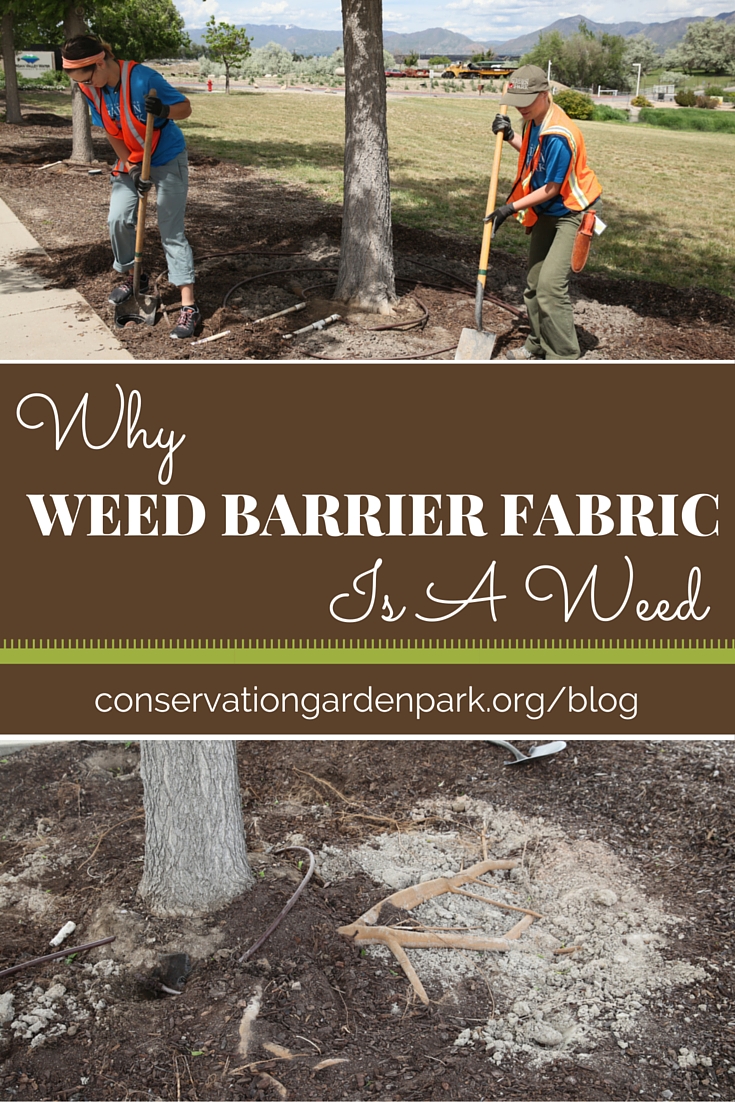
Why Weed Barrier Fabric is a Weed
-
 Weed barrier fabric was a fairly new product when the original part of the Conservation Garden Park was planted in 2001. Like everyone else, we had hoped that it would be a miracle weed reducer. We were wrong. To be clear, when we say "weed barrier fabric" we are referring to the tightly woven mesh-like version generally purchased in rolls. In theory, this mesh is permeable, allowing infiltration of water and air. In theory. The solid black plastic sometimes called weed barrier fabric is something else entirely and we have yet to find a circumstance where we'd recommend it's use.
Weed barrier fabric was a fairly new product when the original part of the Conservation Garden Park was planted in 2001. Like everyone else, we had hoped that it would be a miracle weed reducer. We were wrong. To be clear, when we say "weed barrier fabric" we are referring to the tightly woven mesh-like version generally purchased in rolls. In theory, this mesh is permeable, allowing infiltration of water and air. In theory. The solid black plastic sometimes called weed barrier fabric is something else entirely and we have yet to find a circumstance where we'd recommend it's use.
Weed barrier fabric worked well in the first season and delivered as promised. In the second season, it was a little less effective because weed seed can still blow in from other places and sit on top of the fabric in the mulch, eventually germinating and becoming weeds. Of course, once this happens, it's a slow decline each season as the fabric is less and less effective at negating weeds. More concerning; however, are the soil problems the fabric creates.
Over the last 3 years have been removing it and it’s proven to be a real misery to “eradicate” so we can restore the soils in those areas to health. We hope this article helps you avoid this pitfall in planting beds or, if it is already existing in your landscape, shows you why and how to correct the problem. There are places weed barrier fabric is useful in the landscape-- just not in planting beds.
This season our efforts are focused on removing the weed barrier fabric that was installed along with the street trees on the Conservation Garden Park street frontage. The trees are nearly mature after 15 years and peeling back the layers of compost and tattered weed barrier fabric have revealed some very big issues created by the fabric. A huge thanks goes to our seasonal staff who have been painstakingly digging out and removing the old fabric—it’s everyone’s least-favorite chore. -
Reasons NOT to use Weed Barrier Fabric:
Reason 1: It doesn’t work.
Yep, you read that right, it doesn’t even achieve its stated goal of holding down weeds. To be fair it does do a reasonable job of this for the first year, maybe two. But after that period of time you have plenty of weed seeds established on top of the fabric and you will no longer notice any difference. Once those weeds start sprouting, the roots can get tangled in the fabric making them even harder to remove, causing an even more difficult weed situation than if you didn’t have the fabric in place at all.
-
Reason 2: It Kills Your Soil
Like, kills it dead. Worms and other microorganisms are constantly hard at work in soil. They break down and incorporate organic matter into the soil, their tunnels aerate the soil and cause aggregates to form, which helps with water penetration into the soil. All of this activity is great for soil, which is great for plants. It can’t happen with weed fabric in place. The fabric prevents organic matter from getting into the soil, which makes it unlivable for those worms and beneficial microorganisms. Without that activity the soil becomes barren, compacted and dry. In other words: dead. The lack of natural nutrients forces the use of artificial fertilizers.
The lack of aeration makes the ground compacted which forces roots to stay on the surface, making them less resilient to drought. The compacted soil becomes dry because water runs off the surface instead of penetrating the earth and allowing plants to take it up.
-

-
Reason 3. It kills your plants.
The standard way to use weed fabric is to lay it down and cut holes where the trees, shrubs or flowers go. But, unless you go out every year and increase the size of the holes you cut, those plants could outgrow that hole fairly quickly. Trees stuck in a hole cut into weed fabric can become girdled and die as it outgrows these holes. Flowers can try to spread and end up spreading on top of the fabric instead of in the soil beneath making them less healthy while restricting their growth potential.
-
What To Do Instead?
Instead of weed barrier fabric, using a HEAVY coat of organic mulch 2-4” deep will accomplish the same thing while dramatically improving the health and quality of your soil. How deep your mulch needs to be depends on the material used. Small, fine particle mulches such as compost or "soil pep" are dense and do a great job blocking out light so 2-3" is sufficient. Shredded bark has larger chunks that can let light through so using 3-4" would be best.
Organic mulch will break down and provide nutrients to the soil over time. Top dressing with a light coat of mulch (1”) in subsequent years keeps the depth of mulch consistent and the benefit in effect. When organic mulch is used, your soil is continuously improved as the organic matter and nutrients it contains works its way through the soil and feeds both plants and the beneficial life in the soil itself. Over time, your soil becomes better and better-- instead of falling into the state of decline experienced beneath weed barrier fabric.
-

-
When WOULD You Use Weed Barrier Fabric?
Despite it's failure to work as intended, weed barrier fabric is still useful in certain landscape situations. It's still our preferred fabric to use beneath gravel, decomposed granite (or similar) or other inorganic permeable materials used for informal landscape paths. The fabric keeps the gravel from being absorbed into the soil and helps keep the path intact. It is best used beneath inorganic materials, like gravel, that have some heft and weight to them. When used beneath mulch, the slick surface of the fabric makes it too easy for wind to lift the mulch off the path.
-


